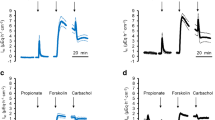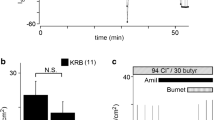Abstract
Irinotecan (CPT-11) is active against a broad range of human cancer. One of the side-effects of irinotecan is a strong diarrhoea. In order to investigate the mechanism underlying this diarrhoea, the effect of irinotecan on anion secretion across the isolated rat distal colon was studied. Irinotecan caused a concentration-dependent increase in short-circuit current (Isc). The increase in Isc was completely dependent on the presence of Cl− ions and was supressed by furosemide and the Cl− channel blocker NPPB (5-nitro-2-(3-phenylpropylamino)-benzoate), indicating that it is caused by a Cl− secretion. The secretory response was inhibited by indomethacin, 1-benzylimidazole, a thromboxane synthase inhibitor, and SK&F 88046 ((N,N′bis-[7-(3-Chlorobenzeneaminosulfonyl)-1,2,3,4-tetrahydroisoquinolyl)disulfonylimide), a thromboxane A2 receptor blocker. In isolated crypts irinotecan had no effect on the membrane potential. Consequently, the secretion induced by irinotecan is an indirect one, caused by the stimulation of eicosanoid production, e.g. thromboxane A2, in the subepithelial tissue.
Similar content being viewed by others
References
Andres H, Bock R, Bridges RJ, Rummel W, Schreiner J (1985) Submucosal plexus and electrolyte transport across rat colonic mucosa. J Physiol 364:301–312
Beubler E, Kollar G, Saria A, Bukhave K, Rask-Madsen J (1989) Involvement of 5-hydroxytryptamine, prostaglandin E2, and cyclic adenosine monophosphate in cholera toxin-induced fluid secretion in the small intestine of the rat in vivo. Gastroenterology 96:368–376
Böhme M, Diener M, Rummel W (1991) Calcium- and cyclic-AMP-mediated secretory responses in isolated colonic crypts. Pflügers Arch 419:144–151
Cabantchik ZI, Greger R (1992) Chemical probes for anion transport of mammalian cell membranes. Am J Physiol 262:C803-C827
Chipperfield AR (1986) The (Na+ -K+ -Cl−) co-transport system. Clin Sci 71:465–476
Coleman RA, Smith WL, Narumiya S (1994) VIII. International union of pharmacology classification of prostanoid receptors: Properties, distribution, and structure of the receptors and their subtypes. Pharmacol Rev 46:205–229
Craven PA, DeRubertis FR (1983) Patterns of prostaglandin synthesis and degradation in isolated superficial and proliferative colonic epithelial cells compared to residual colon. Prostaglandins 26:583–604
Diener M, Gartmann V (1994) Effect of somatostatin on cell volume, Cl− currents, and transepithelial Cl− transport in rat distal colon. Am J Physiol 266:G1043-G1053
Diener M, Rummel W (1991) Carbocyclic thromboxane A2 inhibits Cl− absorption in the rat colon. Eicosanoids 4:225–230
Diener M, Bridges RJ, Knobloch SF, Rummel W (1988) Neuronally mediated and direct effects of prostaglandins on ion transport in rat colon descendens. Naunyn-Schmiedeberg's Arch Pharmacol 337:74–78
Diener M, Rummel W, Mestres P, Lindemann B (1989) Single chloride channels in colon mucosa and isolated colonic enterocytes of the rat. J Membrane Biol 108:21–30
Diener M, Eglème C, Rummel W (1991) Phospholipase C-induced anion secretion and its interaction with carbachol in the rat colonic mucosa. Eur J Pharmacol 200:267–276
Field M, Semrad CE (1993) Toxigenic diarrheas, congenital diarrheas, and cystic fibrosis: disorders of intestinal ion transport. Annu Rev Physiol 55:631–655
Fukuoka M, Niitani H, Suzuki A, Motomiya M, Hasegawa K, Nishiwaki Y, Kuriyama T, Ariyoshi Y, Negoro S, Masuda N, Nakajima S, Taguchi T (1992) A phase II study CPT-11, a new derivative of camptothecin, for previously untreated non-small-cell lung cancer. J Clin Oncol 10:16–20
Goerg KJ, Nell G, Rummel W (1982) Effect of deoxycholate on the perfused rat colon. Concentration dependence of their effect on net fluid and electrolyte transfer and the correlation with paracellular permeability. Digestion 26:105–113
Goerg KJ, Diener C, Diener M, Rummel W (1991) Antisecretory action of prostaglandin D2 in rat colon in vitro: action sites. Am J Physiol 260:G904-G910
Kawato Y, Aonuma M, Hirota Y, Kuga H, Sato K (1991) Intracellular roles of SN-38, a metabolite of the camptothecin derivative CPT-11, in the antitumor effect of CPT-11. Cancer Res 51:4187–4919
Kenyon JL, Gibbons WR (1977) Effect of low-chloride solutions on action potentials of sheep cardiac purkinje fibers. J Gen Physiol 70:635–660
Kunimoto T, Nitta K, Tanaka T, Uehara N, Baba H, Takeuchi M, Yokokura T, Sawada S, Miyasaka T, Mutai M (1987) Antitumor activity of 7-ethyl-10-[4-(1-piperidino)-1-piperidino]carbonyloxy-camptothecin, a novel water-soluble derivative of camptothecin, against murine tumors. Cancer Res 47:5944–5947
Masuda N, Fukuoka M, Kusunoki Y, Matsui K, Takifuji N, Kudoh S, Negoro S, Nishioka M, Nakagawa K, Takado M (1992a) CPT-11:A new derivative of camptothecin for the treatment of refractory or relapsed small-cell lung cancer. J Clin Oncol 10:1225–1229
Masuda N, Fukuoka M, Takada M, Kusunoki Y, Negoro S, Matsui K, Kudoh S, Takifuji N, Nakagawa K, Kishimoto S (1992b) CPT-11 in combination with cisplatin for advanced non-small-cell lung cancer. J Clin Oncol 10:1775–1780
Nicolaou KC, Magolda RL, Claremon DA (1980) Synthesis of thromboxane A2 analogs. Adv Cyclic Nucl Res 6:481–483
Ohno R, Okada K, Masaoka T, Kuramoto A, Arima T, Yoshida Y, Ariyoshi H, Ichimura M, Sakai Y, Oguro M, Ito Y, Morishima Y, Yokomaku S, Ota K (1990) An early phase II study of CPT-11:a new derivative of camptothecin, for the treatment of leukemia and lymphoma. J Clin Oncol 8:1907–1912
Rainsford KD (1988) Inhibitors of eicosanoid metabolism. In: Curtis-Prior PB (ed) Prostaglandins: biology and chemistry of prostaglandins and related compounds. Churchill Livingstone, Edinburgh, pp 52–68
Sakai H, Takguchi N (1993) Small-conductance Cl− channels in rabbit parietal cells activated by prostaglandin E2 and inhibited by GTP gamma S. J Physiol 461:201–212
Sharon P, Stenson WF (1985) Metabolism of arachidonic acid in acetic acid colitis in rats. Similarity to human inflammatory bowel disease. Gastroenterology 88:55–63
Slichenmyer WJ, Rowinsky EK, Donehower RC, Kaufmann SH (1993) The current status of camptothecin analogues as antitumor agents. J Nat Cancer Inst 85:271–291
Smith PL, McCafferty GP, Fondacaro JD, Wasserman MA, Elton E, Ryan FM (1988) Effects of putative thromboxane receptor agonists and antagonists on rat small intestinal ion transport J Pharmacol Exp Ther 247:143–149
Tai HH, Yuan B (1978) On the inhibitory potency of imidazole and its derivatives on thromboxane synthetase. Biochem Biophys Res Commun 80:236–242
Takeuchi S, Noda K, Yakushiji M, CPT-11 Study Group on Gynecologic Malignancy (1992) Late phase II study of CPT-11, topoisomerase I inhibitor, in advanced cervical carcinoma (CC). Proc ASCO 11, 224
Wangemann P, Wittner M, DiStefano A, Englert HC, Lang HJ, Schlatter E, Greger R (1986) Cl−-channel blockers in the thick ascending limb of the loop of Henle. Structure activity relationship. Pflügers Arch 407:S128-S141
Weichman BM, Wassermann MA, Gleason JG (1984) SK&F 88046:A unique pharmacologic antagonist of bronchoconstriction induced by leukotriene D4, thromboxane and prostaglandin F2alpha and D2 in vitro. J Pharmacol Exp Ther 228:128–132
Author information
Authors and Affiliations
Rights and permissions
About this article
Cite this article
Sakai, H., Diener, M., Gartmann, V. et al. Eicosanoid-mediated Cl− secretion induced by the antitumor drug, irinotecan (CPT-11), in the rat colon. Naunyn-Schmiedeberg's Arch Pharmacol 351, 309–314 (1995). https://doi.org/10.1007/BF00233252
Received:
Accepted:
Issue Date:
DOI: https://doi.org/10.1007/BF00233252




